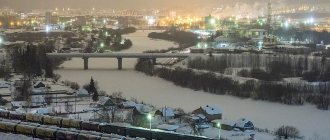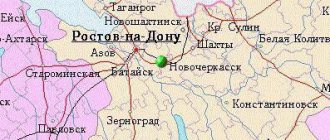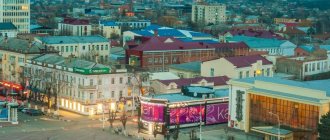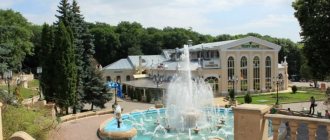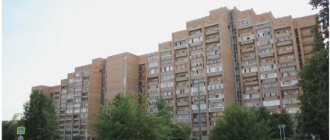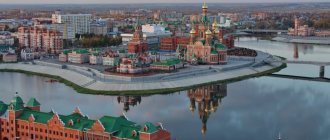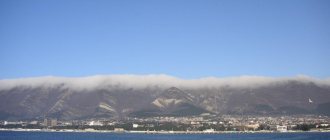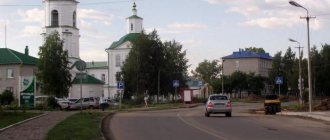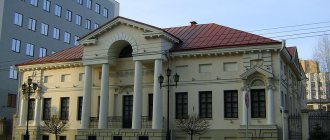- September 2, 2019
- Directions
- Andrey Ruzaev
Not everyone knows where Ukhta is. And it is located in the very center of the Komi Republic and is a relatively small town. These regions themselves are rich in forests and have a beautiful but harsh nature. The city itself is equated to the regions of the Far North. It grew out of the notorious camps of the Soviet past, then developed thanks to oil production. And now the second most important city in the region is Ukhta. It’s easy to guess which one comes first - Syktyvkar (administrative center).
The beginning of the city's history
The area around the Ukhta River, where the city will be in the future, began to be developed by people mainly thanks to oil. The settlement itself would then be named after her. This small river is a tributary of the Izhma, which in turn flows into the Pechora. It carries its waters north, to the ocean. Here, where the Ukhta (river) is located, they began to extract oil for the first time in Russia. This currently valuable mineral was found back in the 15th century, but they didn’t know how to use it then. Oil was used only for medical purposes and for lubricating mechanisms.
Monument to graduates of the Ukhta school who died in the Great Patriotic War
The monument is located in the center of the main alley of the Children's Park, on a round platform, which was formerly called “Pioneer Glory Square”. The memorial consists of bas-relief images of pioneers and soldiers of the Soviet Army, as well as battle flags bowed in grief, painted on a concrete slab. Also attached to the slab are plaques with the names of fellow countrymen who died in the war.
Monument to graduates of the Ukhta school who died in the Great Patriotic War
Location: Children's park.
Oil production
Oil exploration was first organized in 1745 by the ore explorer Pryadunov. We can say that the city of Ukhta is where oil is produced in Komi today. But it was not always so. At first it was drawn from wells and springs. The distillation was carried out in Moscow, 3.6 tons of “flammable water” were brought to the laboratory. Not much by modern standards, but this is just the beginning. Even then, this oil was appreciated; it was studied in Hamburg and recognized as “no worse than Italian.” Oil was extracted very slowly by dredging from the surface of the water and from coastal pits.
For this purpose, specially on the river, at the place where the oil spring is located, a wooden frame was erected and a cutwater was made (a stone dam to fence off the frame from the river). A special container with a hole at the bottom was placed inside it; oil flowed through it on its own, rising to the surface of the water. From there they scooped it up with birch bark ladles.
At the moment, this technology seems ineffective, but at that time there was no alternative. Soon misfortunes began: first, during a river flood, the production well was destroyed, then Pryadunov was sent to prison due to non-payment of tithes. Ukhta oil was remembered only in 1868, and production resumed thanks to the merchant Sidorov. He allocated funds for drilling a well.
Then this was not the only production area; there were already wells in Galicia and Baku. Under Sidorov's leadership, about 33 tons of oil were produced. Local black gold was examined by Mendeleev himself and highly appreciated its qualities.
Climate
Ukhta has a continental subarctic climate[10] (DFC) with long cold winters and short warm summers. Compared to areas of similar latitude in Siberia, winters are less severe, but still much longer than summers and very cold by European standards.
| Climate data for Ukhta | |||||||||||||
| Month | Jan | Feb | Mar | Apr | May | Jun | Jul | Aug | Sep | October | But I | December | Year |
| Record high °C (°F) | 2.5 (36.5) | 3.0 (37.4) | 13.0 (55.4) | 23.8 (74.8) | 30.1 (86.2) | 33.5 (92.3) | 35.2 (95.4) | 32.5 (90.5) | 27.4 (81.3) | 20.0 (68.0) | 8.2 (46.8) | 3.6 (38.5) | 35.2 (95.4) |
| Average high °C (°F) | −13.1 (8.4) | −10.9 (12.4) | −2.4 (27.7) | 4.6 (40.3) | 12.0 (53.6) | 19.0 (66.2) | 22.1 (71.8) | 17.3 (63.1) | 10.7 (51.3) | 2.8 (37.0) | −6.0 (21.2) | −10.6 (12.9) | 3.8 (38.8) |
| Daily average °C (°F) | −16.5 (2.3) | −14.7 (5.5) | −6.8 (19.8) | −0.5 (31.1) | 6.3 (43.3) | 13.3 (55.9) | 16.5 (61.7) | 12.4 (54.3) | 6.9 (44.4) | 0.4 (32.7) | −8.9 (16.0) | −13.8 (7.2) | −0.5 (31.1) |
| Average low °C (°F) | −20.0 (−4.0) | −18.1 (−0.6) | −10.9 (12.4) | −5.0 (23.0) | 1.5 (34.7) | 8.2 (46.8) | 11.6 (52.9) | 8.4 (47.1) | 4.0 (39.2) | −1.8 (28.8) | −11.3 (11.7) | −17.2 (1.0) | −4.2 (24.4) |
| Record low °C (°F) | −48.5 (−55.3) | −43.9 (−47.0) | −39.2 (−38.6) | −28.4 (−19.1) | −16.9 (1.6) | −4.2 (24.4) | −0.4 (31.3) | −3.9 (25.0) | −8.8 (16.2) | −26.4 (−15.5) | −37.8 (−36.0) | −49.0 (−56.2) | −49.0 (−56.2) |
| Average precipitation mm (inches) | 32 (1.3) | 26 (1.0) | 29 (1.1) | 28 (1.1) | 44 (1.7) | 66 (2.6) | 71 (2.8) | 69 (2.7) | 54 (2.1) | 55 (2.2) | 40 (1.6) | 39 (1.5) | 553 (21.8) |
| Source: Weatherbase[11] | |||||||||||||
First settlement
For the first time, the village of Chibyu appeared on the site where the city of Ukhta is located, which happened after the revolution, in 1929. This was the first full-fledged settlement. Since 1933, Chibyu became the center of Ukhtpechlag (one of the centers of the Gulag). An unfavorable and difficult time for people, but it gave development to the village. In addition, thanks to its location in the very center of the Komi Republic, Chibyu grew and developed. Soon a new name appeared - Ukhta. At one time they even wanted to make this urban-type settlement the administrative center of the region, but all plans were confused by the war. At the same time, Ukhta received city status.
Memorial to fellow countrymen-participants of the Great Patriotic War
This monument to Ukhta front-line soldiers was erected in the city in 1980. Construction completed in 1984. The memorial is made in the form of a five-pointed star inscribed in a circle with a 14-meter diameter. From its rays rise 15-meter planes, symbolizing half-mast banners.
Memorial to fellow countrymen-participants of the Great Patriotic War
These planes are united by a ring, on the inner side of which a wreath is depicted, and on the outer side - five Orders of the Patriotic War. The eternal flame stands on a base made of Karelian granite. Granite steps lead to the pedestal. On the square in front of the main monument of the memorial there are eight granite pedestals with inscriptions.
Location: in the park on the bank of the Ukhta River, at the intersection of Mira and Oktyabrskaya streets.
Camp times
The infamous Ukhtpechlag is associated with Ukhta. The Ukhta-Pechora camp included a huge territory of 1.5 million km2 with its center in Ukhta. What a vast area, and yet everything is dedicated to prison! It also included the upper and middle reaches of the Vychegda and the Pechora basin. The camps also captured the Timan Ridge. If you look on old maps of Russia to find out what region Ukhta is in, then on them it was listed as the Autonomous Region of Komi. Today it is not part of the region, but of another subject of the Federation - the Komi Republic.
The Ukhtpechlag administration was located in Chibyu (present-day Ukhta). Since 1931 it has been one of the Gulag prison centers. More and more prisoners were brought here along the highway.
The barracks were overcrowded; according to data, there were about two thousand people here. In 1929, a mechanical repair plant opened here. It was thanks to the repressed that the village began its intensive development, and the development of the north took place. The prisoners had a lot of hard and life-threatening work; not everyone lived to see their release. They mined coal, obtained radium from local radioactive waters in laboratories, and significantly increased the volume of oil produced. The world's only oil mine was built in the upper reaches of the Yarega River, where they began to extract heavy oil. A vocational school was even organized, where the necessary specialists were trained from prisoners.
Intercity modes of transport in Ukhta
There are several enterprises constantly operating in Ukhta that provide intercity transport services. Depending on the travel route, guests and residents of the city can use Russian Railways buses or passenger trains.
The Ukhta bus station is located on the street. Oktyabrsk, house No. 24. The operating hours of this enterprise are from 05-00 to 21-00, seven days a week. Departure and arrival of intercity buses occurs exclusively at local time.
The Ukhta city bus station operates on the following routes:
- Ukhta - Vuktyl. The bus departs daily at 07:00, 14:00 and 18:00. The average ticket price is 849 rubles.
- Ukhta - Kazan. The flight departs daily at 09:00 and 18:00. The fare is 3,399 rubles.
- Ukhta - Kirov. The bus leaves from the bus station at 09-00 every day. The average ticket price does not exceed 2000 rubles.
- Ukhta - Sterlitamak. At 09-00 a transit flight passes through the city bus station with a stop from 2 to 5 minutes. This time is enough for passengers to load their luggage into the luggage compartment of public transport and then take their seats. At 12-00 a comfortable Mercedes bus leaves Ukhta with a direct connection to Sterlitamak. The ticket price is 4925 rubles.
- Ukhta - Syktyvkar. This direction of intercity communication is the most developed. Bus routes to the capital of the Komi Republic depart daily at 05-00, 09-00, 14-00, 18-00 and 22-00. The average fare is 894 rubles.
- Ukhta - Ufa. On Wednesdays and Sundays, the bus leaves at 05-40. There is also another daily flight on this route with intercity transport leaving at 09-00. The ticket price does not exceed 5,400 rubles.
You can get to the Ukhta bus station by public transport.
It is recommended to use the following city routes under No.:
- 1a;
- 19;
- 7;
- 12;
- 11;
- 10;
The average fare on Ukhta city buses is 24 rubles. There is a permanent information desk with a contact telephone number on the territory of the Ukhta bus station. Residents and visitors of the city can contact a transport company employee to receive information about updates and changes in the intercity service schedule.
Competition for the city bus station in terms of intercity transportation comes from the Ukhta ATP. This company provides transportation services for citizens on the route: Ukhta - Syktyvkar. The average fare for an adult is 800 rubles. one way. For children under 12 years of age, the ticket price is set at 400 rubles.
Passengers who often travel on this route have the opportunity to apply for a Unified Transport Card at the Ukhta ATP. This service will be relevant for city guests who travel in large groups.
ATP of the city of Ukhta is located on the street. Zapadnaya, house no. 8.
All information regarding intercity flights of this company can be obtained by calling:
- +7;
- 8 (8216) 740-200.
Passengers are transported by modern and comfortable PAZ buses, as well as Mercedes Sprinter. The Ukhta automobile company provides bus rental services for individual intercity trips.
For example, for transporting large and medium-sized tourist groups between populated areas and natural attractions of the Komi Republic.
The city of Ukhta is located in a region whose climate is equal to the conditions of the Far North. The soil here freezes to a depth of 2 m. Despite this, several passenger and freight railway lines are constantly operating in the city.
The railway station in Ukhta is located on the street. Vokzalnaya, building No. 1. Rail transport is considered one of the fastest, safest and most comfortable methods of intercity communication. The railway station is located at a distance of over 2500 m from the city center, and is also separated from the main part of Ukhta by a river.
Residents and guests of Ukhta who need to get to the railway station can use the services of bus route No. 2 (departure from Kuratova Street, travel through the central streets to the railway station). The average fare is 24 rubles.
People who want to save on public transport can go to the train station on foot. On average, the path from the city center to the street. Vokzalnaya, 1 will take from 30 to 40 minutes. This takes into account that the person will walk at an average pace.
The table below shows the schedule of railway transport routes, with the help of which residents and guests of Ukhta can use intercity services.
| Railway route | Departure time | Arrival time | Days of the week |
| Nizhny Novgorod — Vorkuta | 17-48 | 17-38 | Transit train No. 090G through Ukhta runs daily. |
| St. Petersburg — Vorkuta | 19-04 | 18-49 | Passing express train No. 078Ya moves through Ukhta every day. |
| Moscow — Vorkuta | 20-48 | 20-31 | Transit train No. 376Ya daily. Tickets for this route must be purchased in advance, as they are always in demand. |
| Moscow — Vorkuta | 01-01 | 00-51 | Branded express No. 042B, which passes through Ukhta on even dates. |
| Usinsk — Syktyvkar | 01-27 | 01-16 | Transit route with daily movement of passenger train No. 305Ya. |
| Labytnangi — Moscow | 01-47 | 01-37 | Intercity transport services are provided by. Train No. 021Н runs daily. |
| Vorkuta — Adler | 02-57 | 02-47 | Passing passenger train No. 309С, which passes through Ukhta daily. |
| Syktyvkar — Usinsk | 03-27 | 03-07 | Transit express No. 306Ya with daily service. |
| Vorkuta — Moscow | 06-32 | 06-22 | Branded passenger train No. 041M with an increased level of comfort passes through Ukhta every day. |
| Usinsk — Syktyvkar | 12-53 | 12-48 | Daytime express No. 053Ya, which provides Ukhta residents with daily intercity service. |
| Adler — Vorkuta | 16-52 | 16-42 | Passing train No. 310E, which runs daily, connecting the southern and northern regions of the Russian Federation. |
| Moscow — Vorkuta | 01-01 | 00-51 | Branded long-distance express No. 042B, which passes through Ukhta on odd dates. |
| Usinsk — Syktyvkar | 01-27 | 01-16 | Passenger train No. 305Ya moves through Ukhta in transit every day. Average parking duration is 5 minutes. |
| Syktyvkar — Usinsk | 03-27 | 03-07 | Passing train No. 306Ya with daily service. |
Using railway transport, Ukhta residents and city guests have the opportunity to get to almost any region of the Russian Federation with a minimum number of transfers.
Kashketi executions
In 1936, protests began among political prisoners. They demanded their separate maintenance from criminals, improved living conditions and normal medical care. In 1937, 6,890 prisoners were already serving their sentences in the camp.
Since 1938, mass executions began under the leadership of Lieutenant Kashketin. At that time, 86 prisoners were executed in the village of Chibyu. And in the area of the Ukhtarka River, 1,779 people were shot in a short time. In order to destroy such a number of people in a short time, they resorted to a trick. They organized a “transition” from one camp to another, lined up the prisoners in a column and led them through the tundra, where an ambush and a prepared grave awaited them. All prisoners were shot with a machine gun. These events would later be called the “Kashketi executions.” Soon after this, the village left the Gulag, and power again transferred to the Komi administration.
Museum of Liquidators of Technogenic Disasters
This museum opened in Ukhta on April 26, 2013, on the 27th anniversary of the Chernobyl nuclear power plant accident, on the initiative of a local public organization of Chernobyl liquidators. Its museum doors are always open to everyone, and primarily to schoolchildren.
Here the children are told about the essence of the Chernobyl disaster and about the work of fellow countrymen who took part in eliminating its consequences. Among the exhibits of the museum are the protective suits in which the liquidators worked, various dosimeters that measured the level of radiation, children's creative works on the theme of Chernobyl, photographs from the sites of those dramatic events and photographs of the liquidators of the accident themselves.
Museum of Liquidators of Technogenic Disasters
Educational films and videos about the accident at the Chernobyl nuclear power plant and the liquidation of the consequences of other man-made disasters in the USSR and Russia are shown.
After such an excursion, children can confidently talk about the Chernobyl accident in class and correctly answer any questions regarding this event.
Address: Kosmonavtov Ave., 19.
Architecture
A typical northern Russian city with a mining industry is Ukhta. You can see right away where the city-forming enterprises are located.
If you look at the city from an elevated position, you can see an industrial zone in one part of the view. Here is the Ukhta oil refinery, which was launched during the Gulag period (in 1934).
In another part you can see the residential buildings of the city; they, like steps, go from bottom to top. This is due to the fact that the city was built on the Timan Ridge. The buildings are dominated by high-rise buildings from the 60s to 80s. The massive Oil and Gas Research Institute is also visible. There is also the old town, the embankment of the Ukhta River, the victory memorial and the Lukoil office.
Museum of 20th Century Migrants
A private museum, created by a local collector-enthusiast, head of the research club, Victor Moor. The museum was based on its collection of antiques, things and household items of the first half of the twentieth century.
This extraordinary exhibition is housed in a railway carriage built in 1902. Most of the exhibits presented in the museum came from immigrants to Ukhta from other regions of Russia - hence the name.
Museum of 20th Century Migrants
In addition to the unique feeling of traveling back in time, a visit to the Museum of 20th Century Migrants gives the visitor a deep understanding of how much human life has changed over these decades, how much easier and more comfortable it has become for everyone these days.
Address: st. Bushueva, 5b.
Old city
You can see interesting architecture in the old town. Ancient buildings were once created in the USSR according to the designs of talented architects P.K. Murzin and Zhizhimontov. One of them was a prisoner. Although they were both from Moscow, the Leningrad style can be seen in the old city.
The old town, built in the 50s, sets Ukhta apart from other cities with the oil industry. The streets are wide, the buildings are all different, but in a common style. On the houses themselves there are a lot of small and large decorative elements from the times of the USSR. It feels like a short but interesting story.
There is a local history museum, and next to it is a monument in the form of a stone, stern and gloomy, dedicated to the innocent victims of repression. There are also technical schools in the city: Mining and Railway transport. The same wooden barracks and buildings from which the village of Chibyu, which later became Ukhta, began, have been preserved.
In Ukhta you can see a memorial and chapel dedicated to the memory of those who died during the fire in the shopping center. 25 people were burned alive, mostly employees of the shopping center. According to the official version - arson, two teenagers were sentenced to life imprisonment.
The Temple of Stephen of Perm makes an interesting impression. Looking at it, it is difficult to believe in the church purpose of this building. In appearance, it is an ordinary cultural center, although very beautiful. And indeed, it used to house the oil workers' recreation center. Only in 1994 it was converted into a temple. They say that the architect Zhizhimontov, who designed this building, was a believer and always dreamed of building a temple. Thus, his dream came true, but not immediately, but after about half a century. However, dreams come true, no matter what.
Monument to the Prometheans of the North
Driving along the Syktyvkar-Ukhta highway, at the entrance to the city you can see an extraordinary monument to an oil and gas industry worker. Surrounded by pipes, he lights a torch that brings warmth to the people. This monumental sculpture is dedicated to all participants in the development of local deposits and is called “Prometheans of the North”.
Monument to the Prometheans of the North
The monument was erected in November 2003. This is a bronze monument, 4 meters high, mounted on a high granite pedestal. The author of the monument was the famous sculpture from Syktyvkar A.I. Neverov. The worker’s sculpture fits well into the surrounding area and rightfully became one of the main symbols of the city of Ukhta.
Address: Lenin Ave., 50.
Prologue
The organizer of the debate was the Youth Branch of the Russian Society of Political Scientists in the republic. The moderator of the debate was the chairman of MolROP, third-year political science student Nikita Kraev. The experts were journalist Daria Shuchalina, one of the initiators of the referendum Evgeny Vologin, associate professor of the history department Fyodor Ivanov and doctor of historical sciences Yuri Shabaev.
— An important indicator is social demand - interest in the very topic of the referendum and in moving the capital. This idea has become a national theme,” the moderator said at the beginning of the debate.
First, we watched the first episode of the video blog of the writer Grigory Spichak, in which he discusses the idea of a referendum. “The idea does not come from Nikolai Denisovich Tskhadai at all, he just articulated it, just voiced it. I wouldn’t be surprised if this is an idea from Rosneft or Gazprom,” Spichak says in his blog. According to the organizers, this is “the only interesting video material on this topic”, and it should have served as a good prologue. Due to the poor sound from the speakers, many did not understand what was going on. After the video, the discussion moderator introduced the invited experts and gave them the floor.
Two teams took part in the debate, each of which included one political scientist and two journalists. After the speech of one of the parties, questions were asked by rivals, experts, the moderator and the audience. By lot, the team that was against moving the capital from Syktyvkar to Ukhta came out first.
